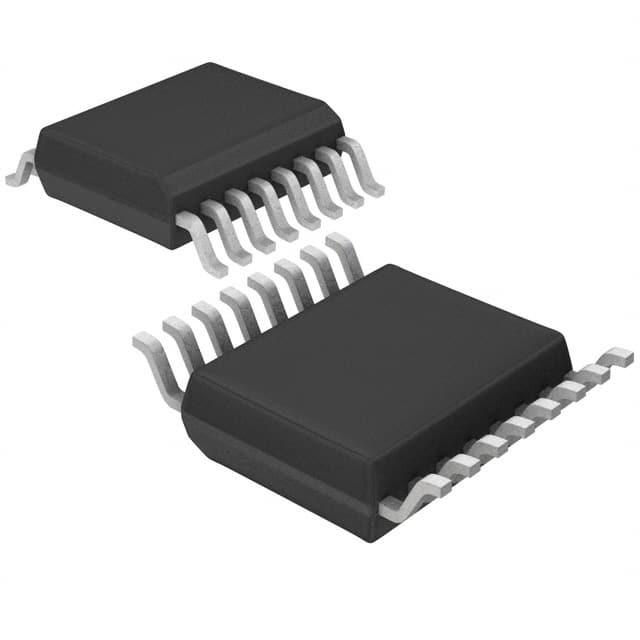ADS7846EG4
Product Overview
Category: Integrated Circuit (IC)
Use: The ADS7846EG4 is a touch screen controller IC used for interfacing resistive touch screens with microcontrollers or other digital devices.
Characteristics: - High resolution and accuracy - Low power consumption - Wide operating temperature range - SPI interface for communication - Supports 4-wire resistive touch screens
Package: The ADS7846EG4 is available in a small form factor package, such as QFN (Quad Flat No-Lead) or TSSOP (Thin Shrink Small Outline Package).
Essence: This IC acts as an intermediary between the touch screen and the microcontroller, enabling accurate touch input detection and conversion into digital signals.
Packaging/Quantity: The ADS7846EG4 is typically sold in reels or trays containing multiple units. The exact quantity depends on the manufacturer and distributor.
Specifications
- Resolution: Up to 12 bits
- Operating Voltage: 2.7V to 5.25V
- Operating Temperature Range: -40°C to +85°C
- Communication Interface: SPI (Serial Peripheral Interface)
- Touch Screen Support: 4-wire resistive touch screens
- Power Consumption: Low power mode available
Detailed Pin Configuration
The ADS7846EG4 has several pins that serve different purposes. Here is a detailed pin configuration:
- VCC: Power supply voltage
- GND: Ground reference
- DOUT: Serial data output
- DIN: Serial data input
- CS: Chip select for SPI communication
- BUSY: Indicates touch screen activity
- PENIRQ: Interrupt request signal for touch events
- XR, XL, YU, YD: Analog inputs for touch screen coordinates
Functional Features
- Touch Screen Calibration: The ADS7846EG4 supports touch screen calibration to ensure accurate touch input detection.
- Noise Filtering: Built-in noise filtering algorithms help reduce interference and improve touch screen performance.
- Low Power Mode: The IC offers a low power mode for energy-efficient operation.
- Interrupt Support: The PENIRQ pin allows the microcontroller to receive interrupts when touch events occur.
Advantages and Disadvantages
Advantages: - High resolution and accuracy provide precise touch input detection. - Wide operating temperature range makes it suitable for various environments. - Low power consumption prolongs battery life in portable devices. - SPI interface enables easy integration with microcontrollers. - Supports 4-wire resistive touch screens, which are cost-effective and widely used.
Disadvantages: - Limited to resistive touch screens, not compatible with capacitive or other touch screen technologies. - Requires external components for complete touch screen functionality. - May require additional calibration for optimal performance.
Working Principles
The ADS7846EG4 operates by measuring the voltage at the touch screen's analog inputs (XR, XL, YU, YD). It converts these analog voltages into digital values using an internal ADC (Analog-to-Digital Converter). The converted digital values are then communicated to the microcontroller via the SPI interface. By continuously monitoring the touch screen coordinates, the microcontroller can detect touch events accurately.
Detailed Application Field Plans
The ADS7846EG4 is commonly used in various applications that require touch screen interfaces, including: - Consumer electronics: smartphones, tablets, portable gaming devices - Industrial control systems: human-machine interfaces, control panels - Automotive: infotainment systems, navigation devices - Medical devices: patient monitors, diagnostic equipment - POS (Point of Sale) terminals: cash registers, self-service kiosks
Detailed and Complete Alternative Models
- ADS7843: Similar touch screen controller IC with slightly different specifications.
- STMPE610: Touch screen controller IC with I2C interface and additional features.
- TSC2046: Low-power touch screen controller IC with SPI interface.
These alternative models offer similar functionality to the ADS7846EG4 and can be considered as alternatives based on specific requirements and system compatibility.
Word count: 526 words
Lista 10 Vanliga frågor och svar relaterade till tillämpningen av ADS7846EG4 i tekniska lösningar
Sure! Here are 10 common questions and answers related to the application of ADS7846EG4 in technical solutions:
Q: What is ADS7846EG4? A: ADS7846EG4 is a touch screen controller IC commonly used in various technical solutions.
Q: What are the key features of ADS7846EG4? A: Some key features include 12-bit resolution, SPI interface, low power consumption, and support for both resistive and capacitive touch screens.
Q: How does ADS7846EG4 communicate with the microcontroller? A: ADS7846EG4 communicates with the microcontroller using the Serial Peripheral Interface (SPI) protocol.
Q: Can ADS7846EG4 be used with both resistive and capacitive touch screens? A: Yes, ADS7846EG4 supports both resistive and capacitive touch screens, making it versatile for different applications.
Q: What is the maximum resolution supported by ADS7846EG4? A: ADS7846EG4 supports a maximum resolution of 12 bits, providing accurate touch position data.
Q: How much power does ADS7846EG4 consume during operation? A: ADS7846EG4 has low power consumption, typically consuming around 200µA during active mode and less than 1µA in standby mode.
Q: Can ADS7846EG4 be used in battery-powered devices? A: Yes, due to its low power consumption, ADS7846EG4 is suitable for battery-powered devices where power efficiency is crucial.
Q: Does ADS7846EG4 have built-in noise filtering capabilities? A: Yes, ADS7846EG4 incorporates an on-chip filter that helps reduce noise interference and improve touch screen performance.
Q: What is the operating temperature range of ADS7846EG4? A: ADS7846EG4 has an extended operating temperature range of -40°C to +85°C, making it suitable for various environments.
Q: Are there any application examples where ADS7846EG4 is commonly used? A: Yes, ADS7846EG4 is commonly used in applications such as industrial control panels, medical devices, portable instruments, and automotive infotainment systems.
Please note that these answers are general and may vary depending on specific implementations and requirements.


